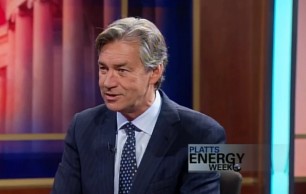Alberta's oil sands crude 'will get to market.
 Companies will keep harvesting bitumen from Alberta’s oil sands, even if a pair of pipelines through North America are blocked, Canada’s U.S. ambassador says.
Companies will keep harvesting bitumen from Alberta’s oil sands, even if a pair of pipelines through North America are blocked, Canada’s U.S. ambassador says.That “oil will get to market,” Ambassador Gary Doer said on Platts Energy Week. The only question is how it gets there, Doer said. “The oil isn’t staying in the ground. It is going to get to the Gulf Coast.”
But oil sands producers are facing trouble on two fronts. Last month, British Columbia formally opposed Enbridge’s plan to build the Northern Gateway pipeline, which would transport oil sands crude through the province to the West Coast. In the United States, environmentalists have been battling TransCanada Corp.’s proposal to build the Keystone XL pipeline connecting Alberta with Gulf Coast refineries.
“We’ve got a delay in British Columbia, and controversy in D.C.,” Doer noted. But, he said, even with the opposition, “it’s not a question of (whether this) oil comes into the United States. It’s a matter of how.”
Other pipelines are a possibility to transport diluted bitumen from Alberta to Canadian ports. Separately, companies are already using rail to ship the Canadian crude across the U.S. border.
Doer’s assertions respond to a major argument from Keystone XL’s critics, who insist that the pipeline is essential to sustaining energy-intensive oil sands development in Canada that yields heavy crude that has a bigger carbon footprint — from its production to combustion — than alternatives.
Earlier this year, the State Department concluded that the project was unlikely to dramatically boost demand for Canada’s oil sands or the amount of heavy crude oil processed in Gulf Coast refineries. According to the State Department analysis, companies will turn to rail and other options to transport the product even if the government denies a permit for Keystone XL, so there would be little change in greenhouse gas emissions tied to oil sands development.
But the issue isn’t settled. The Environmental Protection Agency, which plays a secondary role reviewing the pipeline, suggested that other pipelines and rail transport may not be inevitable and pushed the State Department for a better analysis.
Keystone XL critics say British Columbia’s move is a sign at least one alternative pipeline won’t be built, undermining the State Department’s conclusion that greenhouse emissions will be the same with or without Keystone XL.
But supporters note that British Columbia’s opposition doesn’t put the Northern Gateway on ice. Canada’s federal government still plays a role evaluating the project.
And other pipelines are still in the works, Doer noted, including Kinder Morgan’s Trans Mountain pipeline expansion. Separately, TransCanada has proposed another project that would send oil sands crude to New Brunswick.
The Canadian Association of Oil Producers just predicted that oil sands production will jump to 5.2 million barrels per day by 2030, up from 1.8 million barrels each day now. But CAPP’s forecast came with a warning, as the group insisted that “Western Canadian supplies are essentially landlocked and will need additional transportation infrastructure to bring this growing oil supply to markets.”
Under a 2004 executive order issued by President George W. Bush, the State Department is tasked with determining whether a border-crossing pipeline like Keystone XL is in the “national interest.” But if any one of eight separate federal agencies disagrees with State’s decision, that would launch a process that ultimately could put the final verdict in President Barack Obama’s hands.
You can return to the main Market News page, or press the Back button on your browser.

